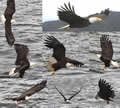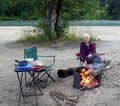2014/06 Haida Gwaii trip - Khutzeymateen |
|||||
Wednesday July 2nd
We were early into Prince Rupert’s Cow Bay to check in for our boat trip into the Khutzeymateen. The trips on days either side of this one were fully booked so we were pleasantly surprised to  find that we had only thirty passengers on the hundred seater boat. My guess was that the full days coincided with the arrival of cruise ships.
find that we had only thirty passengers on the hundred seater boat. My guess was that the full days coincided with the arrival of cruise ships.
We had another great day, sunny and calm, but cool out on deck of course. Doug, the owner and captain, and guides Elaine and Barb did a great job of keeping us aware of where we were. The Khutzeymateen grizzly sanctuary is only 25 miles from Prince Rupert, but there are no roads to it and we were going to be taking two hours to cover twice that distance to come in from the sea.
| To Khutzeymateen (3.18) |
 |
|---|
![]() We left the harbour and took Metlakatla Pass, a narrow channel, formerly the location of several Tsimshian villages. There are still some reservations along this coast,
We left the harbour and took Metlakatla Pass, a narrow channel, formerly the location of several Tsimshian villages. There are still some reservations along this coast,  accessible only by boat. We came to the more open waters of Chatham Sound, part of the Inside Passage used by the Alaska ferries. We were still protected from the Pacific’s swells by Dundas Island to our west. Off to our east was Port Simpson, another Tsimshian village. We stopped briefly at Parten Island, a perch for eagles and seals. We turned briefly into Portland Inlet, which goes all the way to Stewart and Hyder (where we were in 2005), then into Steamer Passage and finally the imposing Khutzeymateen Inlet with its cliffs and glaciers and mountains. The scenery would be worth the trip even if we didn’t see any bears.
accessible only by boat. We came to the more open waters of Chatham Sound, part of the Inside Passage used by the Alaska ferries. We were still protected from the Pacific’s swells by Dundas Island to our west. Off to our east was Port Simpson, another Tsimshian village. We stopped briefly at Parten Island, a perch for eagles and seals. We turned briefly into Portland Inlet, which goes all the way to Stewart and Hyder (where we were in 2005), then into Steamer Passage and finally the imposing Khutzeymateen Inlet with its cliffs and glaciers and mountains. The scenery would be worth the trip even if we didn’t see any bears.
| Khutzeymateen bears 1 (17.22) |
 |
|---|
| Khutzeymateen bears 2 (17.19) |
 |
|---|
 In early summer, the bears come down onto the stream estuaries to eat grass and dig for clams. They stay there until the salmon start their migration up the streams and the bears move to the spawning beds. Doug’s boat can’t go there so in a few weeks he would switch to whale watching. Luckily for us the salmon hadn’t arrived yet and we saw plenty of bears, all grizzlies. We were allowed out on deck but not to speak, for fear of spooking them. Doug would bring the boat in close and put it into slow spin. Even with only thirty of us, we took a lot of accidental photos of each other’s hats and noses.
In early summer, the bears come down onto the stream estuaries to eat grass and dig for clams. They stay there until the salmon start their migration up the streams and the bears move to the spawning beds. Doug’s boat can’t go there so in a few weeks he would switch to whale watching. Luckily for us the salmon hadn’t arrived yet and we saw plenty of bears, all grizzlies. We were allowed out on deck but not to speak, for fear of spooking them. Doug would bring the boat in close and put it into slow spin. Even with only thirty of us, we took a lot of accidental photos of each other’s hats and noses.
We reckoned about fifteen sightings, but some were the same bears seen twice, so perhaps ten or eleven in all. Most were eating grass, a large part of any bear’s diet. One big bear was sitting on the beach watching us, fidgeting around to get comfortable. Behind, and out of its sight, another smaller bear was in the long grass. The big bear must have picked the scent as it was suddenly up and looking. The other stood up to get a better view and then galloped off into the forest.
| Khutzeymateen bears 3 (15.23) |
 |
|---|
Most entertaining was a pair of last year’s cubs, recently orphaned. They were digging for clams, and turning over rocks and logs looking for food. They would swim from rock to rock. Sadly, without their mother around to teach them where to go and how to fish for salmon, Doug thought they were unlikely to survive.
Our trip back was a lot rougher, pounding into a southerly wind. Doug took us in close to these spectacular rocks, a favourite spot for the whales but not today. Later, we spotted a humpback whale, but it was too rough to go out on deck. Although we saw the humpback’s tail high out of the water most of us just got pictures of the blows and splashes. These whales spend the winter near Hawaii but come to the BC coast to feed in the summer.
| Return from Khutzeymateen (4.27) |
 |
|---|
| Eagle feeding (5.37) |
 |
|---|
 For a last treat, Doug stopped the boat and lobbed food scraps into the sea, telling us we were about to see either a lot of gulls or a lot of eagles. We were lucky; the eagles had already recognized the boat and were whirling around us. It’s a somewhat artificial situation but it’s not often you see thirty eagles in action.
For a last treat, Doug stopped the boat and lobbed food scraps into the sea, telling us we were about to see either a lot of gulls or a lot of eagles. We were lucky; the eagles had already recognized the boat and were whirling around us. It’s a somewhat artificial situation but it’s not often you see thirty eagles in action.
We were back in midafternoon, with time for some shopping and then to begin our trip back to Hope. Sandie wanted to camp at the Exstew River, where we’d had lunch two weeks earlier. The water level was down so the road was dry this time and we camped on the river bed, with a few distant neighbours. There was plenty of wood around so we cooked over a fire. That’s the Exstew behind Sandie, a large river but much, much larger during the spring runoff.
We must have arrived during the bug siesta, as the mozzies suddenly attacked in force just as we were dozing in front of the fire.